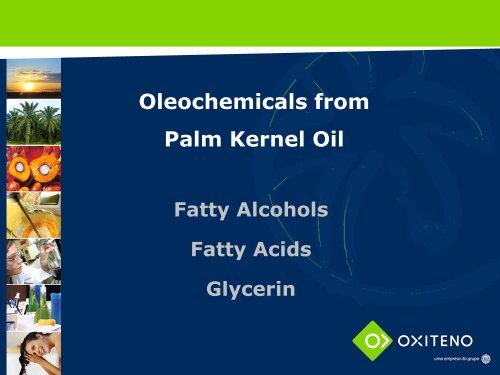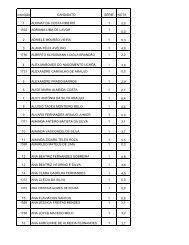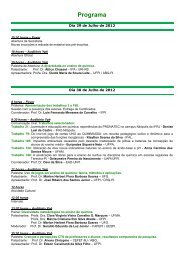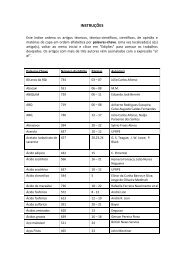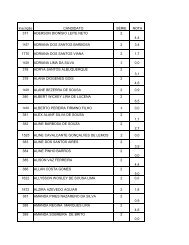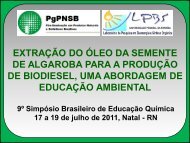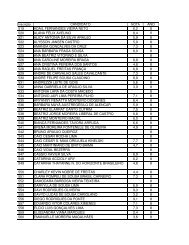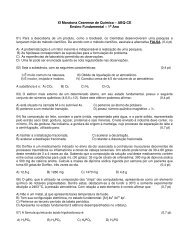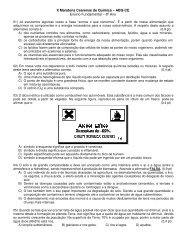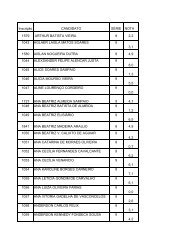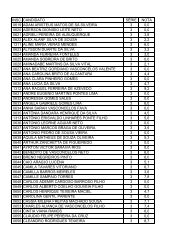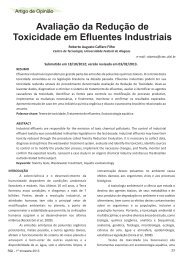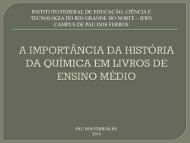Oleochemicals from Palm Kernel Oil - abq
Oleochemicals from Palm Kernel Oil - abq
Oleochemicals from Palm Kernel Oil - abq
Create successful ePaper yourself
Turn your PDF publications into a flip-book with our unique Google optimized e-Paper software.
<strong>Oleochemicals</strong> <strong>from</strong><br />
<strong>Palm</strong> <strong>Kernel</strong> <strong>Oil</strong><br />
Fatty Alcohols<br />
Fatty Acids<br />
Glycerin
Purpose<br />
• Share with this committees and participants the<br />
experience and challenges faced by Oxiteno in<br />
establishing a new plant that processes vegetable<br />
feedstock, for instance palm kernel oil.
Investment<br />
• Oxiteno invested more than US$ 100 million, building<br />
a new Fatty Alcohol industrial unit in Brazil, the<br />
Oleoquimica<br />
• The new unit has capacity to process 100,000<br />
tons/year of Vegetable <strong>Oil</strong>s to produce Fatty Alcohols,<br />
Fatty Acids and Glycerin<br />
• First Fatty Alcohol unit in Latin America<br />
• The new unit also produces different kinds of Fatty<br />
Acids, with molecular chains <strong>from</strong> 8 to 18 carbons,<br />
including hydrogenated acids
Feedstocks<br />
Vegetable <strong>Oil</strong>s
Raw Materials<br />
<strong>Palm</strong> <strong>Oil</strong> (Dendê)<br />
Shell<br />
Fiber<br />
<strong>Palm</strong> <strong>Kernel</strong> <strong>Oil</strong><br />
Coconut <strong>Oil</strong><br />
COPRA<br />
(Pulp)<br />
Babassu <strong>Oil</strong><br />
Production Proportion<br />
<strong>Palm</strong>: <strong>Palm</strong> <strong>Kernel</strong> = 10:1
The major sources for lauric (C12) and myristic acids<br />
(C14) are <strong>Palm</strong> <strong>Kernel</strong> and Coconut <strong>Oil</strong>s<br />
CHAIN<br />
NAME<br />
PALM KERNEL<br />
(PKO)<br />
COCONUT<br />
(CO)<br />
PALM<br />
(CPO)<br />
SOY<br />
TALLOW<br />
C6 CAPROIC 0.3 0.3<br />
C8 CAPRIC 4.5 7.5<br />
C10 CAPRILIC 3.5 8.0<br />
C12 LAURIC 48.2 46.7 0.2<br />
C14 MYRISTIC 16.0 18.0 1.0 2.0<br />
C16 PALMITIC 7.5 9.0 44.0 6.5 35.0<br />
C18 (Total) STEARIC 20.0 10.0 54.8 92.8 63.0<br />
C20 ARAQUIDIC 0.7
The Oleochemical Unit
Location - Bahia State - Brazil<br />
Brazil<br />
Bahia State<br />
Argentina<br />
S. Paulo State
Location
Location<br />
Photo: April/06<br />
Bahia<br />
Pulp<br />
Columbian<br />
White<br />
Martins<br />
BASF<br />
OLEOQUÍMICA<br />
Braskem
Location<br />
Photo: April/06
Location<br />
Photo: August/08
Location<br />
Photo: August/08
Fatty Acids and Glycerin Plant<br />
First Step: Vegetable oil will be hydrolyzed into Fatty<br />
acids and Glycerin<br />
C8–C10<br />
Acid<br />
Fatty<br />
C12-C18<br />
PKO<br />
Hydrolysis<br />
Acid<br />
Fatty acid<br />
distillation<br />
Acid<br />
Crude<br />
Glycerin<br />
Concentration<br />
Refine<br />
Glycerin<br />
99.7% USP<br />
WATER<br />
PKO = <strong>Palm</strong> <strong>Kernel</strong> <strong>Oil</strong>
Fatty Alcohol Plant<br />
Second Step: Fatty acids are converted into methylester<br />
and hydrogenated into Fatty Alcohols<br />
C12–C14 Alcohol<br />
METHANOL<br />
HYDROGEN<br />
C12–C18<br />
Fatty acid<br />
Methyl<br />
Ester<br />
Methylester<br />
Fatty<br />
Alcohol<br />
Fatty Alcohol<br />
Fatty Acid<br />
esterification<br />
Hydrogenation<br />
distillation<br />
WATER<br />
C16C18 Alcohol<br />
C16 Alcohol<br />
C18 Alcohol
Process Flow<br />
<strong>Oil</strong>s Hydrolysis Reaction<br />
<strong>Palm</strong> <strong>Kernel</strong> <strong>Oil</strong> Glycerin Fatty Acids
Process Flow<br />
Esterification Reaction<br />
Fatty Acids Methanol Methyl Esters<br />
Hydrogenation Reaction<br />
Methyl Ester<br />
Fatty Alcohol
Main Uses of<br />
Fatty Alcohols
Detergent Alcohols<br />
• Detergent alcohols are chemicals used as intermediates for<br />
Surfactants Production (e.g. alcohol ethoxylates, alcohol<br />
sulfates, alcohol ether sulfates) or as components in Personal<br />
Care and Household Products<br />
• Detergent alcohols can be classified as:<br />
Fatty Alcohols if derived <strong>from</strong> natural oils<br />
Synthetic Alcohols if derived <strong>from</strong> oil and natural gas<br />
• Oxiteno is the major consumer of detergent alcohols in<br />
Latin America
Products Line<br />
• Total capacity: 95 kt/year of Oleochemical Products<br />
Chemical<br />
Description<br />
Carbon Chain<br />
Length<br />
Capacity<br />
(ton)<br />
Lauryl Alcohol C 12 -C 14 47.000<br />
Cetostearyl Alcohol C 16 -C 18 23.000<br />
Cetyl Alcohol C 16 5.000<br />
Stearyl Alcohol C 18 2.000<br />
Capric-Caprylic Acid C 8 -C 10 7.000<br />
Glycerin C 3 11.000<br />
Total 95.000
Fatty Acids and Glycerin<br />
Fatty Alcohols<br />
Photo: August/08
Fatty Acids and Glycerin Unit
Fatty Alcohols Unit
Storage Tanks for Products
Flocculation Unit
Challenges<br />
A new plant requires new competencies and knowledge which<br />
need to be developed throughout the years.<br />
About the feedstock…<br />
• Supply <strong>from</strong> Malaysian and Indonesian suppliers<br />
• Storage capacity of 2.5 months for raw materials<br />
RSPO – Roundtable on Sustainable <strong>Palm</strong> <strong>Oil</strong><br />
• As Brazil presents the ideal conditions to produce <strong>Palm</strong> <strong>Kernel</strong><br />
<strong>Oil</strong>, Oxiteno is a member of RSPO organization and it is<br />
concerned about developing alternative suppliers in Brazil.
Conclusion<br />
To sum it up the challenges have been overcome and we are<br />
achieving a good level of knowledge on:<br />
- How to operate the plant making the most of it;<br />
- How to manage vegetable feedstocks;<br />
- How to improve our sustainable portfolio;<br />
- Operation under fraction mode and manager by products<br />
As a conclusion...
Conclusion<br />
Crude <strong>Oil</strong><br />
Naphtha<br />
Basic<br />
Petrochemical<br />
Ethylene<br />
Oxiteno<br />
Oxiteno<br />
Derivados<br />
Oleoquímicos<br />
Renewable<br />
Source<br />
Vegetable <strong>Oil</strong><br />
SURFACTANTS OLEOCHEMICALS PRETROCHEMICAL<br />
S<br />
POLYOLS<br />
CATALYSTS
THANK YOU!


